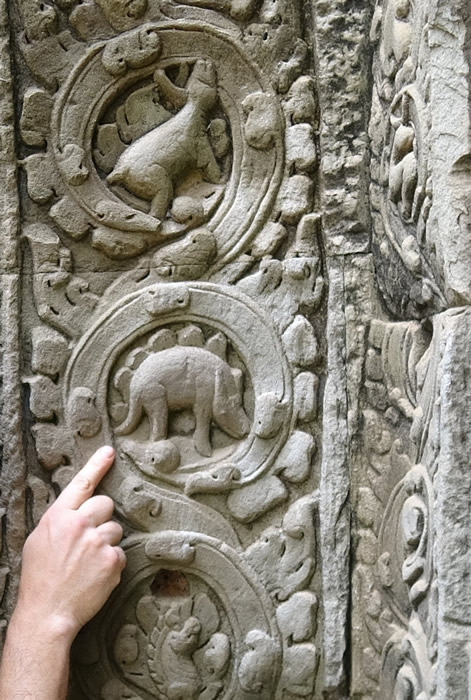The Commission of Ta Prohm
In the late 12th century, King Jayavarman VII of the Khmer Empire undertook the construction of Ta Prohm, an extraordinary temple complex located near the iconic Angkor Wat. This temple, originally known as Rajavihara, was built as a Buddhist monastery and university, and is famous today for its breathtaking integration with nature, as massive trees intertwine with the ancient stone walls. The temple was designed not only to honor the king’s mother but also to serve as a spiritual hub within the empire.

Among Ta Prohm’s many impressive features, however, one particular carving stands out: a curious figure that appears to resemble a stegosaurus, a dinosaur species long extinct by the time the temple was built.
The Intriguing Carving
Hidden within the labyrinthine walls of Ta Prohm, this hand-sized carving has sparked fascination and debate. Positioned in a relatively obscure section of the temple, it has largely been protected by the gnarled roots of ancient banyan trees that have engulfed much of the structure. The figure’s likeness to a stegosaurus, with its characteristic back plates, has captured the imaginations of archaeologists, scholars, and visitors alike. The question is: could ancient Khmer artisans have somehow known about dinosaurs, or is this a coincidence?
Theories and Interpretations
The resemblance to a dinosaur has led to various interpretations. Some suggest the carving could be the result of ancient knowledge passed down through generations or even a rediscovery of prehistoric fossils. This hypothesis, though fascinating, remains highly speculative.

More grounded theories argue that the carving is simply a stylized representation of a contemporary animal known to the region during the Khmer period. Some propose that it could be a depiction of a rhinoceros, with its rounded back and armor-like skin, or even a chameleon—creatures familiar to the ancient Khmer people. The ornate art style of the Khmer Empire often stylized and exaggerated features of animals and mythical creatures, which could explain the unique appearance of this carving.
Khmer Artistry and Symbolism
The artisans of the Khmer Empire were renowned for their intricate craftsmanship. Throughout Ta Prohm, they carved elaborate reliefs of gods, mythical beings, and animals, reflecting both religious devotion and the empire’s artistic achievements. This stegosaurus-like figure may very well be part of that tradition—an example of how the ancient Khmer people merged the natural world with spiritual and cultural symbolism.

The Enduring Mystery
To this day, the exact meaning and inspiration behind the stegosaurus carving remain a mystery. Some view it as an exciting anomaly, while others interpret it as a typical example of Khmer artistic exaggeration. What’s clear, however, is that the carving adds to the allure and mystique of Ta Prohm, drawing visitors not only to witness the grandeur of the temple but also to ponder its enigmatic artistic details.
Conclusion
The stegosaurus carving at Ta Prohm continues to fuel curiosity and debate, offering a tantalizing glimpse into the mysteries of ancient Khmer art and symbolism. Whether it is an intentional depiction of a long-extinct creature or simply a stylized representation of a local animal, this small yet remarkable feature contributes to the temple’s enduring appeal. It stands as a testament to the ingenuity of Khmer artisans and the temple’s role as a monument of Cambodia’s rich cultural heritage.

